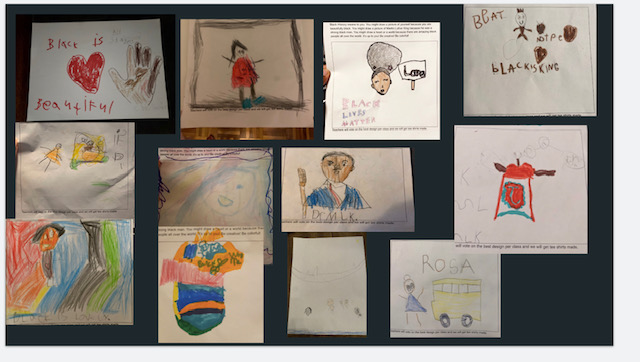Sign up for our daily edtech news briefing today, free.
The coronavirus pandemic has changed a lot in the world since its massive onset nearly one year ago — particularly in the field of education. Nearly simultaneously, though, race relations in America have undergone a change, spurring necessary discussions surrounding the killings of George Floyd and Breonna Taylor, and larger issues as they relate to bias, discrimination and lack of freedoms for marginalized groups.
Both shifts mean that educators are arriving at a different Black History Month landscape than they faced in February 2020 — one that presents opportunities for fresh conversations, research and engagement.
Analiese White, M.Ed., of California has been a language arts teacher for 20 years, with much of that time spent as a middle-school teacher at a Title I school in a farming community. Many of her students are children of immigrants.
“A common Black History Month assignment I have seen throughout my teaching career is to find someone who accomplished something great and then write about or do some other project about that person,” White said. “I needed to delve deeper this year, and earlier.”
Before her students, who were learning virtually, were released for summer break, White assigned them a timeline project. She asked them to find several perspectives on important moments in race history in the country and then share what they found, using online project management tools.
“Many of my students saw their own struggles in those of the people they highlighted for their timelines,” White said. “They also discovered on their own in doing the research that much of the history they’d learned surrounding race was more complicated and nuanced than originally presented in textbooks.”
Middle-schoolers, White says, are at a particularly good age to start to put the pieces together and question the status quo.
“They are still very much blank slates in a lot of ways but developmentally ready to dig in to difficult topics and have what they learn start to shape their own personalities,” White said.
Indiana elementary music teacher Kristen Garrett, M.Ed., has taught about Black influence in music throughout her 16-year career, but this is the first year she’s planned out her Black History Month lessons to accommodate a large number of virtual students. Garrett toggles between in-person students and those learning at home, recording ahead of time for asynchronous instruction.
To keep instruction as similar and engaging between the in-person and remote students, Garrett has found creative ways to tap technology, including creating weekly videos on Canvas with her instruction.
“I also created a bulletin board outside of my classroom featuring records from Black musicians. I duplicated this bulletin board in a Google Slides presentation so students can click on each record to read about the artist and listen to a sample of his/her music,” Garrett said.
Some of her students are learning about the song “Lift Every Voice and Sing,” based on the poem written by NAACP leader James Weldon Johnson.
“We will do some minimal singing of it, but for pandemic reasons, most of our learning will be focused on listening to recordings of it,” Garrett said, adding that she loves the recent performance of the song by Alicia Keys for the NFL.
Music is typically an engaging way to teach younger students about Black history — but is more difficult during a pandemic, Garrett said.
“We’ve developed tools in our toolboxes over the years for student engagement in classrooms. The virtual world throws a different curve ball at us, and I, for one, am still working to figure out what is most effective in this new classroom,” Garrett said.
Katie Mencke, a kindergarten teacher in Massachusetts, says preparation for Black History Month started in September, when her school decided to take an even stronger stance against racism and bias.
“In September, we created a virtual space for students to share their identity and allow them to be who they wanted to be,” Mencke said. “Our Black History Month curriculum is specifically focused on justice, diversity and identity.”
Though her all-virtual students are young, Mencke has been able to engage them in discussions about segregation and how things were different during the civil rights movement. Much of this is done through two to three readings of books, via her webcam, per day.
“Students have also asked parents to go to Black Lives Matter peaceful protests so they can be like the justice seekers we learned about in class,” Mencke said. “Hearing these youngest of our students talk about wanting to make a difference on their own, outside of school assignments, is really encouraging.”
Check out these Black History Month resources:
Black History Month Resource Guide for Educators and Families, from the Center for Racial Justice and Education
Black History Month Lessons & Resources, from the National Education Association
Honoring Black Agency & Black Joy, from Facing History
African American History Month For Teachers, from the Library of Congress
National Museum of African American History and Culture, from the Smithsonian Institution
Katie Parsons edits SmartBrief newsletters on EdTech and Math Education. She has a background in news media, working at the Orlando Sentinel and Chicago Tribune as a researcher and reporter. She is the creator of the parenting blog Mumbling Mommy and her writing has appeared in 150+ online and in-print publications, including the Huffington Post, USA Today, GalTime, ChamberofCommerce.com and Florida Today. She is the co-author of The Five Year Journal, available on Amazon. Contact Katie at katie.parsons@futurenet.com.
________________________________________________________________________________________________________________
Like this article? Sign up for our Edtech news briefing to get news like this in your inbox, or check out all of SmartBrief’s education newsletters, covering career and technical education, educational leadership, math education and more.
More from SmartBrief Education:
- Free resources for educators during the coronavirus pandemic
- Distance learning while respecting students’ home lives
- 8 ways to make vocabulary instruction more effective
